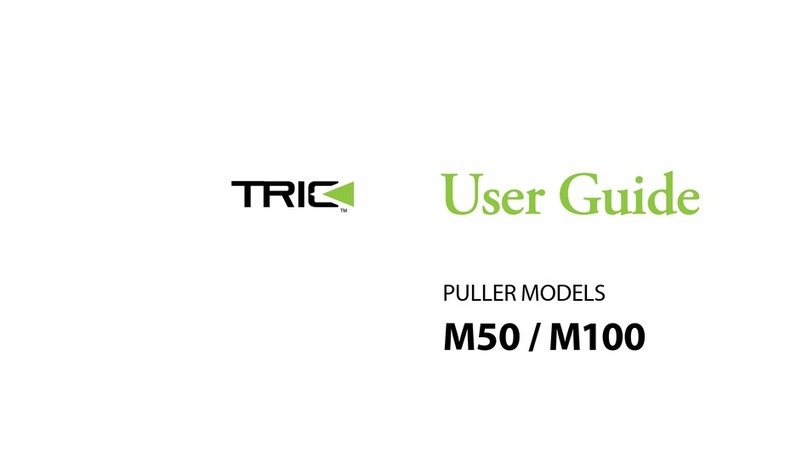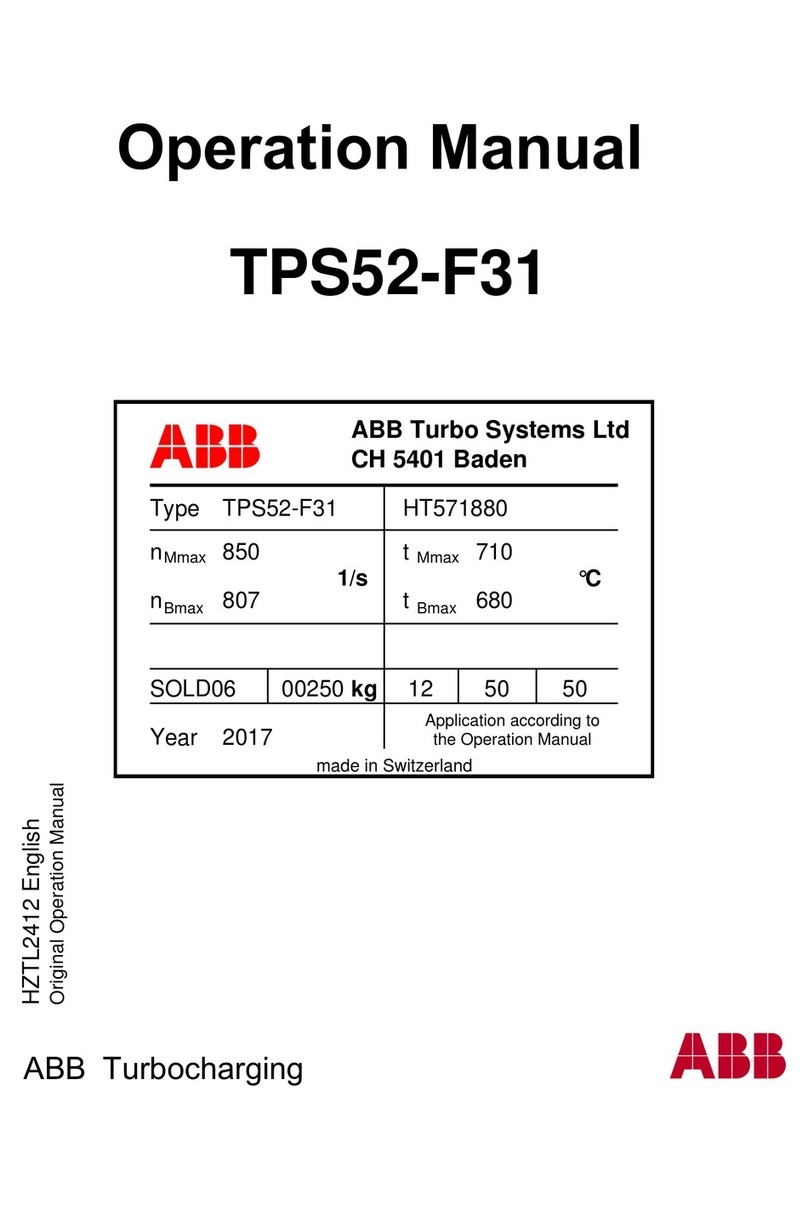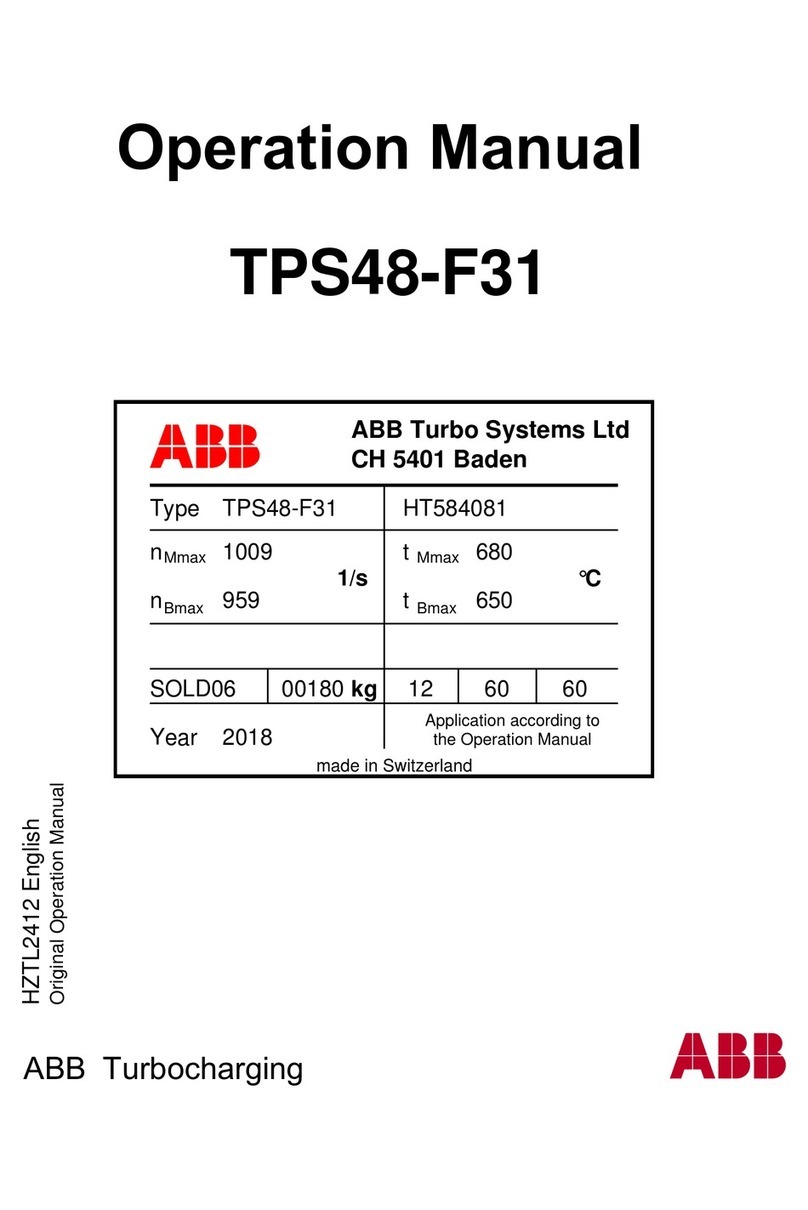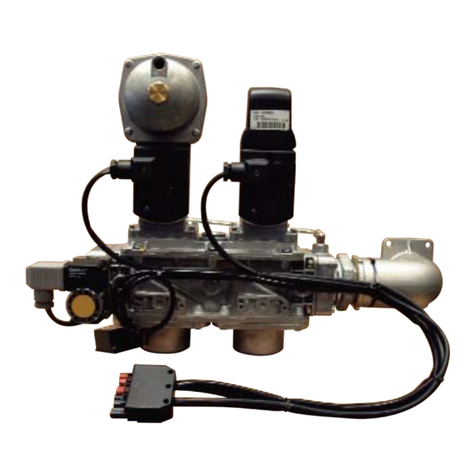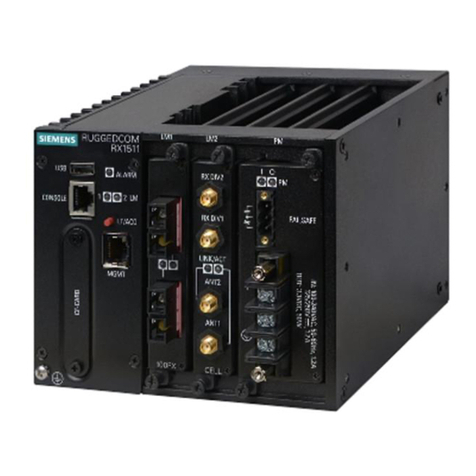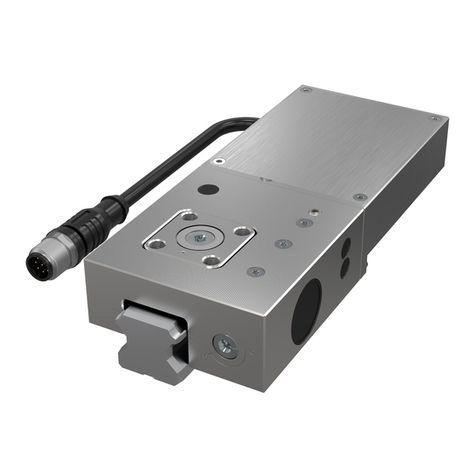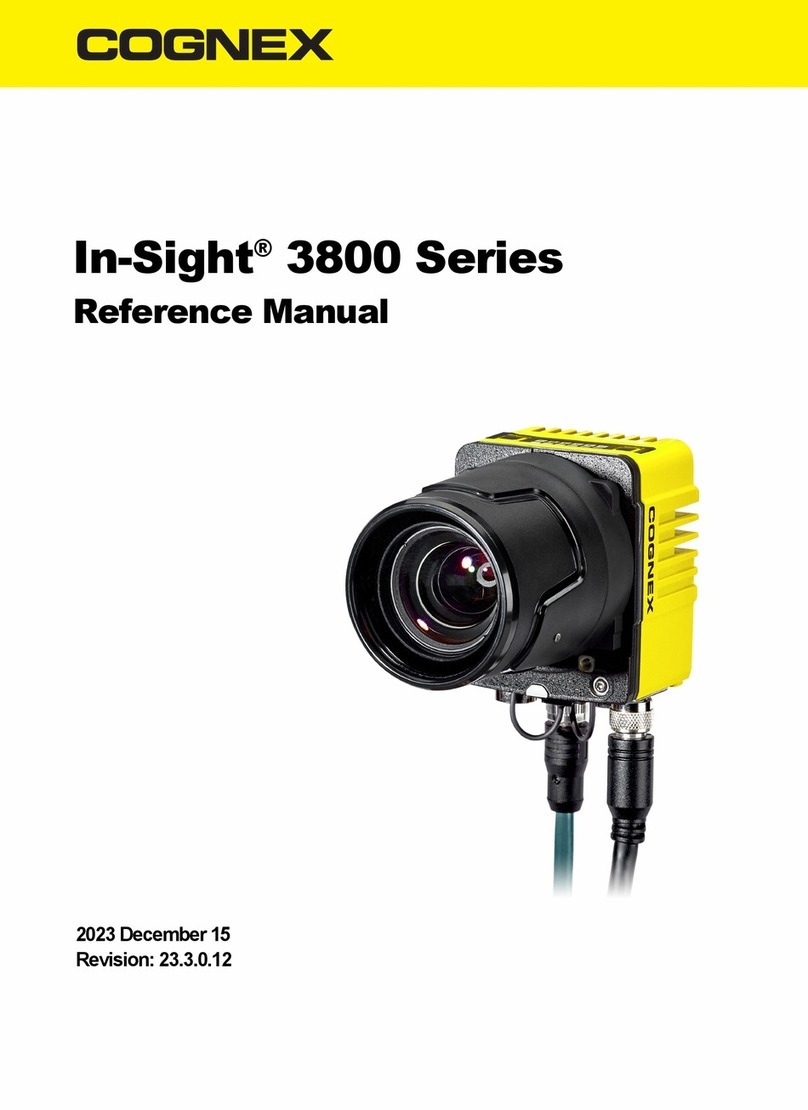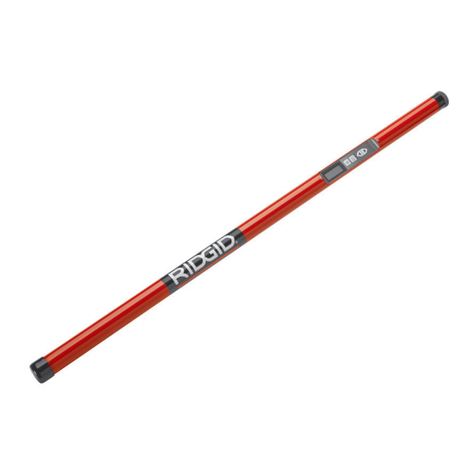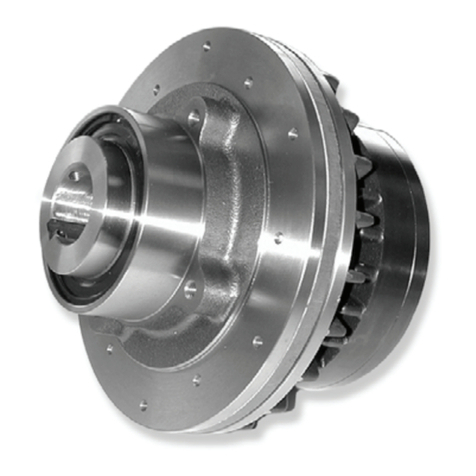tricab X30 User manual

User Guide
X30
PIPEBURSTING SYSTEM
Vision. Invention. Innovation.
®

32
is document was prepared to assist users of trenchless pipe replacement systems manufactured by
TRIC Tools Incorporated (TRIC). Information in this document is subject to change without notice
and therefore does not represent any commitment on the part of the manufacturer. e material
contained herein is supplied without warranty of any kind. TRIC assumes no responsibility and shall
have no liability arising from the supply or use of this document or the material contained herein. No
part of this document may be copied, reproduced, translated, or reduced to any electronic medium
or machine-readable form without prior written consent from TRIC Tools Inc.
e TRIC logo, along with the names X30 and TRIC, are trademarks of TRIC Tools Inc.
All other trademarks are the property of their respective owners.
© 2021 TRIC Tools, Inc. All rights reserved.
Congratulations and thank you for purchasing a TRIC pipebursting system. is visual guide
provides basic yet comprehensive instructions for safe, eective operation and care of your TRIC
equipment. We want to familiarize you with the critical working elements of your TRIC pulling
unit and bursting head assembly, and to illustrate the essential best practices with your system. Our
goal is not to describe every possible bursting scenario, but rather to create a convenient reference
to facilitate more trouble-free operation, and above all to encourage safety on the job.
To that intent, please note the warning symbols in this user guide, which indicate two
levels of concern. e yellow symbol warns against mechanical failure or undue stress
on equipment. e red warning indicates danger of physical injury or death. In some
cases both warning symbols will be displayed at once. In any case, please pay close atten-
tion to all safety topics covered in this manual. SAFETY FIRST!
We are continually improving our products and actively testing them in the eld. We also maintain
working relationships with many of our customers, thus their experience is ours. We are happy
to share this information, along with the latest updates and tips, at www.trictools.com. Or if you
prefer, call us toll-free at 888-883-8742. Welcome to the TRIC Team!
LEGAL NOTICE WELCOME

54
CONTENTS ILLUSTRATIONS
Legal Notice 2
Welcome 3
X30 Assembly 6
Introduction 8
Bursting Preparation 10
Safe Operation 28
Bursting & Splitting Heads 32
Releasing Cable Tension (Detensioning) 42
Troubleshooting and Maintenance 50
Glossary of Terms 52
X30 Puller Components 6
X30 Downhole Assembly 7
Figure 1: Sample Sewer Lateral Path 8
Figure 2: Pulley Wheel Radius & Cable Stress 9
Figure 3: Bursting Head Selection Table 10
Figure 4: Launch Pit Scenario (A) 12
Figure 5: Launch Pit Scenario (B) 14
Figure 6: Clevis & Pulling-Eye Connection 15
Figure 7: Upgrade & Downgrade Bursting 16
Figure 8: Stitching Up A Steep Grade 18
Figure 9: Basic Lateral Bursting Scenarios 20
Figure 10: X30 Unit Dimensions 22
Figure 11: Cribbing With Timbers 24
Figure 12: Cribbing With Poles 25
Figure 13: Loading Cable into Puller 26
Figure 14: Pipe Intrusion 28
Figure 15: Cable Termination & Stopping Point 28
Figure 16: Hydraulic Pulling Force Table 30
Figure 17: Swaged Wire Rope Specs 31
Figure 18: Standard Bursting Head (4” & 6”) 32
Figure 19: TRIC-Lock Components 34
Figure 20: TRIC-Lock Assembly 35
Figure 21: TRIC-Lock Attachment 36
Figure 22: Self-Gripping Head Cable Insertion 38
Figure 23: Self-Gripping Head Chuck Pack 38
Figure 24: Self-Gripping Head Chuck Lube 39
Figure 25: Self-Gripping Head Tail Assembly 40
Figure 26: Self-Gripping Head Assembled 40
Figure 27: Self-Gripping Head Chuck Release 41
Figure 28: Solenoid Valve 50
Figure 29: Drive Coupling 51

76
X30 ASSEMBLY
Handle
Gripper Assembly (pulling)
Gripper Retainer O-Ring
Pulling Bridge
Cover Plate
Piston Shaft
Cylinder Gland
Hydraulic Fitting (retracting)
Cylinder Body & Retaining Bridge
Gripper Assembly (retaining)
Hydraulic Fitting (extending)
Cover Plate
Pressure Relief Plug/Valve
Nose
1
2
3
4
5
6
7
8
9
10
11
12
13
14
X-Series Puller Components*
*Materials and specications subject to change without notice. Shown is the 2021 model with revised pulling bridge.
X30 ASSEMBLY
15
1 2 43 5 6 7 8 9 10 11 12 13 14
1724
18 2019 21 22
16
23
15 Resistance Plate
16 Resistance Plate Bolt & Nut
17 Pulley Base
18 front plate
19 side plate
20 axle
21 top plate
22 wheel
23 annulus/socket
24 Pressure Gauge

98
Vertical pulling essentially denes the original
TRIC method. Along with an open cable path
and sideways cable insertion—i.e. allowing cable
engagement at any point without threading
cable through the puller—the vertical pulling
unit has a compact footprint (20” wide by 18”
long with narrow resistance plate). Cable stress is
concentrated on the wheel radius, as illustrated
in Figure 2 at left. is reduces the overall test
strength rating of the cable by as much as 15%-
20%. For this reason TRIC recommends having
a working pressure gauge at all times to indicate
how hard the unit is pulling. For further infor-
mation on cable strength ratings see Figure 17
on page 31. Also note that wood or other crib-
bing adds extra length to the pulling setup (see
Figure 11 on page 24).
e heart of each TRIC pipe-bursting system
is essentially a cable-pulling device. Cable, or
wire rope, has been an integral part of the TRIC
method since the company introduced trench-
less sewer lateral replacement in 1997. Laterals,
or residential sewers, are often constructed with
bends (directional changes) between the building
foundation and the property line or public sewer
main (see Figure 1). A cable is the most ecient
way to negotiate these bends. It is quite common
to pull through one or two bends in a lateral
job, sometimes three or more. It is also possible
to be stuck at any given point on an unknown
obstacle, or because the pull has not been set up
advantageously. See the next section on Bursting
Preparation for logistical advice on some of the
more typical job scenarios.
INTRODUCTION INTRODUCTION
Figure 2
Pulley wheel radius & cable stress
Figure 1
Sample sewer lateral path
building
property line
sidewalk
street
sewer main
sewer lateral
cleanout
cleanout

1110
BURSTING PREPARATION BURSTING PREPARATION
e TRIC X30 will replace most breakable types
of pipe up to 6” (150mm) in diameter. TRIC
also manufactures a variety of bursting or split-
ting heads, each specic to the type and size of
pipe to be replaced. Please see Figure 3 on the
facing page to select the correct head for the job.
e rst step in any pipe-bursting project is to
locate and expose the existing pipe at each end of
the service line to be replaced. Drain lines should
be recently inspected and located by video, with
all depths, bends, transitions, connections, and
service points (cleanouts) marked on the ground
surface. Launching and receiving pits are cong-
ured dierently from one another, and can have
vastly dierent excavation requirements. Please
review the illustrations on the following pages.
1Vitried Clay (VCP)
2Cast Iron (CI)
3Asbestos Concrete (AC)
4Reinforced Concrete
5Fiber Conduit (Orangeburg)
6Plastic
7Ductile Iron
8Steel
9Copper
BURSTING HEAD PIPE MATERIAL
Standard/Static 1, 2, 3, 5, 6
Impact (Pneumatic)* 1, 2, 3, 4, 6, 7
Swaged Splitter* 2, 6, 7, 8, 9
Link-Blade Splitter* 2, 6, 7, 8, 9
Figure 3
Bursting Head Selection Table
*Special accessories typically used in commercial or municipal applications.

1312
BURSTING PREPARATION BURSTING PREPARATION
Figure 4
Launching pit (Scenario A)
HDPE pipe is exible, which is indispensable for
pipe-bursting applications. e relationship between
pipe diameter and wall thickness (known as SDR or
Standard Dimension Ratio) determines the level of
exibility for each pipe size. A safe formula for the
excavation of launching pits for all sizes of HDPE
pipe is a 30º access angle, or ramp-down to pipe
level. is translates to a surface cut that is roughly
twice as long as the pipe is deep. However, smaller
pipe sizes have smaller bending radii. Figure 4 on
the facing page shows a typical launch scenario for
sewer lateral bursting. Due to the smaller bending
radius of 4” pipe—standard for sewer laterals—a
steeper ramp-down can be used (here shown at 45º).
Allow enough room under the old pipe at the point
of entry (d) to allow exing back to grade and to
facilitate reconnecting the line after the burst.
a
b
c
d
45º
e
a4”– 6” (100–150 mm)
HDPE pipe & bursting head
bCable
cVariable
d1’– 2’ (30–60 cm)
eExisting (old) pipe line

1514
Figure 5
Launching pit (Scenario B)
Figure 6
Clevis & pulling-eye head connection
BURSTING PREPARATION BURSTING PREPARATION
Tight launching pits that are deeper than they
are long are often best negotiated by creating a
“C” curve with the HDPE pipe, as illustrated in
Figure 5 (Scenario B) on the facing page. is
works best with smaller pipe diameters such as
4 inch (100mm) and under. e standard cable
for lateral bursting systems is 3/4” diameter with
an open socket or clevis termination. e large
socket pin that connects the bursting head to the
cable also acts as a hinge to facilitate pipe entry
(see Figure 6). After attaching the bursting head
to the cable, position the head assembly in the
launch pit with the clevis termination inside the
old pipe, and the bursting head with new pipe
diving straight down. As the pull begins, assist
the pipe as it exes into the “C” shape. en as
the pull progresses, maintain a large curve in the
new pipe as it enters the pit.

1716
Since every job is dierent, there are no set
rules for pit preparation and pulling direction.
However, when feasible, bursting up-grade can
be helpful in certain situations. Pulling up-grade
allows the introduction of water to the host pipe
from the upper pulling pit (receiving pit), so
that the bursting head is immersed in water as it
breaks through the old pipe. is lubricates the
host pipe and softens dry surrounding soil as the
bursting head breaks the old pipe and expands
the broken pieces outward. When working in
particularly hard ground conditions, hydraulic
pulling pressures can be reduced by as much as
50% simply by adding water to the host pipe
during a burst. Lower operating pressures gener-
ally result in faster bursting, depending on the
hydraulic power source used. It is not always
necessary or advantageous to add water during a
pull. However, it is important to monitor pull-
ing pressures at all times.
In addition, cast iron bell joints are more easily
broken from behind, that is, pulling up-grade
rather than pulling down-grade into the bell
joint (see Figure 7). is is true whether the
host pipe is wet or dry, and especially true for
cast iron pipe in good condition (i.e., not rusted
through or corroded). In any case, adding water
can be helpful when bursting pressures are con-
sistently high due to dry compact soil. When
high pressures persist, release excess cable ten-
sion (see instructions on page 42 ), leaving only
enough tension to keep cribbing and puller in
place. en insert a garden hose a few feet down
the line and turn water on fully. Reduce or stop
ow if your pulling pit becomes ooded.
Figure 7
Up-grade bursting (green ) versus down-grade bursting (red) in bell-and-spigot cast iron pipe
more dicult
less dicult
BURSTING PREPARATION BURSTING PREPARATION

1918
ab
c
d
Figure 8
Stitching up a steep grade
Figure 8 at left illustrates a common situation,
in which the sewer lateral runs down a steep hill
or embankment, and has bends at both top and
bottom of the slope. If the burst is attempted
from the main ato the building dor vice versa,
depending on ground conditions, the cable will
tend to follow the path indicated by the dotted
orange line, and in many cases will slice out of
the old sewer at street level (a–b), and/or cut into
the earth excessively at the top of the grade c.
is can be avoided by a process called “stitch-
ing.” First, excavate at points a, b, c, and das
shown. Remove old pipe, couplings, and con-
nections from all pits. Fuse enough HDPE pipe
to replace the entire line from main ato building
d, plus an extra 10 or 12 feet (3 or 4 meters).
Attach the bursting head to the new pipe. read
the cable from pit ato pit b. Position the HDPE
pipe and bursting head at launch pit aand con-
nect it to the cable. en insert the puller in pit b
and burst from ato brst. read the cable from
bup to c, during or after the rst pull. When the
bursting head arrives at pit b, move the puller up
to pit cand continue. When the bursting head
arrives at pit c, move the puller up to pit dand
nish the pull. Stitching maintains continuity of
ow path by avoiding three separate launches.
ere is only one launch, with one entire length
of pipe, pulled in three stages. Note also the
resistance wall in pit c, which faces downhill
because it must be perpendicular to the
host pipe path. is is critical for stable,
eective, and safe bursting. Do not use
the ground surface to gauge the angle of the
resistance wall. Use the pipe path instead, and
cut a at wall 90º opposed to the pipe.
BURSTING PREPARATION BURSTING PREPARATION
aEasement/sewer main
bProperty line/cleanout
cBend at top of grade
dBuilding cleanout/foundation

2120
Figure 9
Basic lateral bursting scenarios (overhead view)
d
c
BURSTING PREPARATION BURSTING PREPARATION
Figure 9 opposite shows common examples of
laterals with two or more bends. ese schematics
are all overhead views, as in a road map. Arrows
indicate pull direction, or which way the burst-
ing head is going. A number of factors inuence
which direction to pull, including accessibility of
the pipe at either end, adjacent utilities, slope,
ground conditions, pipe path and material, and
of course physical bends or elbows in the line.
e most common of these are the 1/16 bend
(22.5º) and the 1/8 bend (45º). It’s best to know
the type and number of bends in the line, and
especially where they are positioned in the lateral
path. For example, scenario acould go either
way, with preference to pull from end ybecause
it has the longer section of straight pipe. e
more straight pipe there is in front of the puller,
the less likelihood there is for the cable to cut out
e
preferableacceptable
mandatory
excavation
x
a
x
y
yx
b
y
x
x
y
y
of the pipe path at the receiving pit, and come
out of alignment with the puller. Excessive cut-
ting into the earth with the cable can stop a pull,
break equipment, or both. Scenario bpresents no
challenge in either direction. Scenarios cand d
have clear directional preference due to the very
short distance before a major bend at one end.
However, sometimes it is impractical to place a
pulling pit at the desirable end of the lateral. In
scenario c, end xis where you want the puller,
but if end yis where the pulling pit has to be,
it may be best to dig the 45º bend near end y.
Scenario edepicts a lateral with a combo 90º
bend, possibly found at the corner of a building.
is scenario requires two pulls, with a third
excavation at the 90º bend. In all cases, it is best
to remember that the puller and cable want to
straighten out the line between ends xand y.

2322
Figure 10
X30 unit dimensions and pulling configuration
e X30 pulling assembly is extremely adaptable
to a variety of setup situations. Figure 10 on
the facing page displays the overall dimensions
of the pulling unit. See cribbing examples on
the following pages. Figure 10ashows frontal
dimensions plus the ve dierent options to
attach the wheelbase to the resistance plate. is
oers extreme exibility of operation when there
are adjacent utilities, uneven surfaces, or other
obstacles in the pulling pit. Figure 10bshows
overall height plus minimum setback, as well as
cable path (alignment with host pipe) when the
unit is under load. Note that the resistance plate
must be perpendicular to the host pipe
during the pull, and that the bottom of
the wheel should align with the host pipe.
In other words, the bottom of the wheel is the
center of the pull, which is also the center of
BURSTING PREPARATION BURSTING PREPARATION
24.0 610
24.0
610
5.6
142
10.3
260
13.8
349
52.8
1340
9.5
241
16.9
430
20.0 508
a b c
the resistance plate. erefore the plate needs to
extend below the host pipe to center the pulling
load. See cribbing examples on page 24 showing
wood blocking underneath the host pipe line, as
well as side and top support, to build a “resis-
tance wall” constructed to distribute the load
as evenly as possible in the pulling pit. Blocks
of wood can also be placed under the pulley
base to provide added stability during setup and
operation. Figure 10c demonstrates the ability of
the puller to spin 360º on the pulley base. is
allows further exibility in setup, cable handling,
and routing of hydraulic hoses and pulling cable
during operation. e ability to spin the puller
also allows for correction of cable misalignment
resulting from wear on the wheel, axle, or socket
of the pulley base.

2524
BURSTING PREPARATION
Figure 11
X30 cribbing with lumber
(Shown here are 6”X 6” timbers in 24” and 30” lengths)
BURSTING PREPARATION
e better the setup, the faster, easier, and safer
the job will go. e point is to make the pulling
unit as stable as possible, maintain proper
alignment with the cable when under
load, and monitor hydraulic pressure at
all times. e objective is to create a
“wall of integrity” to spread the load
evenly over as large a surface area as possible in
the pulling pit. Every pit is dierent, so the best
material to accommodate most scenarios is wood
timbers. Keep in mind the “center of the pull,”
as indicated by the green dotted lines in Figure
11 at left. Shown are 6” X 6” timbers in 24” and
30” lengths. Other useful wood sizes are 4” X 6”
and 2” X 6”. When possible, a good way to start
is by setting a horizontal timber under the cable
path, to create a low anchor of support. en
build on that by adding vertical timbers as shown.
Depending on the dimensions of the pit, cribbing
can be stacked horizontally as well as vertically. In
uneven pits with wet or unstable soil, galvanized
steel pipe or fence pole material can be driven
into the ground with a sledge hammer to create
a vertical wall of support (see Figure 12 below).
pipe path and cable alignment
(with acceptable side-to-side deviation)
pipe path
and cable
alignment
Figure 12
(Cribbing With Poles)

2726
BURSTING PREPARATION BURSTING PREPARATION
To get the pulling cable through the old sewer,
rst use a duct-rodder or similar device to navi-
gate the line. If the pipe is clogged or in serious
disrepair, use a sewer snake or hydro-jetter to get
through the line. en pull back a stout nylon
rope or similar strong webbing to pull in the
cable. Attach the new PE pipe to the bursting
head. See instructions on following pages for
TRIC self-gripping head assemblies, and for
fuse-on (PE cap) head assemblies refer to butt-
fusion standards provided by fusion equipment
manufacturers. Position the head and new pipe
at the launch pit, and attach the cable to the
head. Take up cable slack at the pulling pit.
Position cribbing, making any small adjustments
to the pit with hand tools. See pages 24-25 for
cribbing examples. Wood can also be used to
support the pulley base as shown in Figure 13a
at left. is keeps the pulling assembly upright
when no tension is on the cable, and it also
helps stabilize the unit under load. Apply anti-
seize grease or equivalent to the gripper pockets,
and make sure grippers are clean and move freely
up and down before each job. Once cribbing
is set in the pulling pit, position the resistance
plate and attach the pulley base to the plate. Pull
the cable around the wheel and into the annulus
or wheel socket (see Figure 13a). en drop the
puller onto the wheel socket with grippers facing
the cable (see Figure 13b). is “captures” the
cable and makes it easier to load into the puller,
especially when space is limited in the pulling
pit. Open the grippers and roll the cable into
pulling position, then close the grippers around
the cable and attach the retaining O-rings to
each gripper assembly as shown in Figure 13c.
Figure 13
Loading Cable into Puller
abc

2928
a
SAFE OPERATION SAFE OPERATION
Pipe intrusion is a common occurrence in the
receiving pit (see Figure 14 at left). is is when
the old pipe (a) is forced out of the ground towards
the pulling assembly. It happens near the end of
the burst, when the bursting head is close to the
receiving pit. Pipe intrusion is relatively com-
mon when bursting bell-and-spigot cast iron,
particularly when pulling downstream—i.e.,
into the bell or hub—as shown. e resistance
plate (b) has a narrow cable slot (3” or 75 mm)
that will prevent pipe and fragments 3” or larger
in diameter from getting past the resistance plate
and encroaching upon the pulling unit. If pipe
is driven into the receiving pit, it is stopped by
the resistance plate and the pull continues with-
out interruption. When using wood cribbing,
be sure to allow room for the bursting head to
pass the timbers to allow maximum extraction
b
Figure 14
Pipe intrusion
at the end of the pull. Figure 14 shows 6” x 6”
and 4” x 6” timbers in front of the resistance
plate (b). In this example, the timbers anking
the cable/pipe path (dashed green line) create a
gap of about 6” (150 mm) to allow the bursting
head to pass through. For maximum stability
and extra extraction space (c), add more timbers
whenever possible. For example Figure 14 shows
one layer of timbers between soil and resistance
plate, whereas two or three layers (depending on
lumber dimensions) are needed to provide full
extraction space for the bursting head. is is
because the pull must stop when the cable
termination is visible inside the pulley base
(see Figure 15). Keep extraction space (Figure
14c) free of debris and soil as the bursting head
nears the resistance plate. Stop before the clevis
makes contact with the resistance plate.
Figure 15
Cable termination and stopping point
c c

3130
PULLING FORCE (US TONS)
PISTON DIAMETER AND TOTAL SURFACE AREA
MODEL (CYLINDER): X20 (1.625”/41mm), C20 (1.75”/45mm), C25 (2.0”/50mm), X30 (2.5”/64mm), X50 (2.75”/70mm), M50/V24 (3.5”/89mm), M100 (5.0”/127mm)
SAFE OPERATION SAFE OPERATION
Figure 16
Hydraulic Pulling Force Table
Figure 17
Swaged Wire Rope Specifications
STANDARD SWAGED WIRE ROPE (6 x 26 RRL IWRC)
inches mm
DIAMETER
lbs/ft kg/M
WEIGHT
US metric
TEST STRENGTH (TONS)*
1/2 12 N/A N/A N/A N/A
7/8 22 1.66 2.47 47.0 42.6
9/16 14 0.68 1.01 19.3 17.5
1 25 2.15 3.21 61.5 55.8
5/8 16 0.85 1.27 23.9 21.7
1 1/8 28 2.80 4.17 75.0 68.0
3/4 19 1.25 1.87 34.5 31.3
1 1/4 32 3.46 5.15 90.0 81.6
1 3/8 35 4.20 6.23 110 99.8
COMPACT SWAGED WIRE ROPE (6 x 25 RRL IWRC)
inches mm
DIAMETER
lbs/ft kg/M
WEIGHT
US metric
TEST STRENGTH (TONS)*
1/2 12 0.63 0.94 18.6 16.9
7/8 22 1.91 2.85 56.0 50.8
9/16 14 0.78 1.15 23.7 21.5
1 25 2.53 3.77 73.7 66.9
5/8 16 1.01 1.50 28.5 25.8
1 1/8 28 2.89 3.93 92.9 84.3
3/4 19 1.41 2.10 42.2 38.3
1 1/4 32 3.43 4.67 103 93.4
1 3/8 35 4.20 5.72 120 108.9
*Listed for comparison only. Field applications vary. Putting a wire rope under load around a radius (wheel or pulley) degrades factory strength ratings. Actual breaking
point may be reduced by 20% or more when pipe-bursting. Use extreme caution and always have a working pressure gauge on pulling equipment.
Two-Cylinder Ram Pulling Chart
Piston Diameter: X20 = 1.625", C20 = 1.75", C25 = 2", X30 = 2.5", X60 = 2.75", M50 = 3.5", M100 = 5"
Tons of Pull
Area x PSI 1000 2000 3000 4000 5000 6000 7000 8000
1.625" pair
4.15 sq. in. 2.07 4.15 6.22 8.3 10.37 12.44 14.52 16.6
1.75" pair
4.81 sq. in. 2.4 4.81 7.21 9.62 12.03 14.43 16.84 19.24
2.0" pair
6.28 sq. in. 3.14 6.28 9.42 12.56 15.7 18.84 21.98 25.12
2.5" pair
9.82 sq. in. 4.91 9.82 14.73 19.64 24.55 29.46 34.37 39.28
2.75" pair
11.88 sq. in. 5.94 11.88 17.82 23.76 29.7 35.64 41.58 47.52
3.0" pair
14.14 sq. in. 7.07 14.14 21.21 28.28 35.35 42.42 49.49 56.56
3.5" pair
19.24 sq. in. 9.62 19.24 28.86 38.48 48.1 57.72 67.34 76.96
4.0" pair
25.13 sq. in. 12.57 25.13 37.7 50.26 62.83 75.39 87.96 100.56
4.5" pair
31.81 sq. in. 15.91 31.81 47.72 63.62 79.53 95.43 113.34 127.28
5.0" pair
39.27 sq. in. 19.64 39.27 58.91 78.54 98.2 117.81 137.45 157.12
5.5" pair
47.52 sq. in. 23.76 47.52 71.28 95.04 118.8 142.56 166.32 190.08
6.0" pair
56.55 sq. in. 28.28 56.55 84.83 113.1 141.38 169.65 197.93 226.24
6.5" pair
66.37 sq. in. 33.19 66.37 99.56 132.74 165.93 199.11 232.3 265.52
7.0" pair
76.97 sq. in. 38.49 76.97 115.5 153.94 192.43 230.91 269.4 307.92

3332
STANDARD BURSTING HEAD (4” and 6”) with PRE-BURSTER STANDARD BURSTING HEAD (4” and 6”) with PRE-BURSTER
Major components of the TRIC standard bursting head assembly:
(a) mole, (b) removable blade, (c) pulling core, (d) PE cap,
(e) core washer, (f) core bolt.
TRIC standard bursting heads are lighter than
their TRIC-Lock counterparts, and are better
congured to negotiate dicult entry angles and
bends in the pipe path.
TRIC-Lock heads, on the other hand, do not
require fusing to the pipe, which eliminates the
need for PE caps. is is a signicant savings, as
well as a great convenience on the job.
TRIC 4” and 6” bursting head assemblies—both
standard and TRIC-Lock models—employ the
open socket or clevis type cable termination (g)
in Figure 18 opposite, and Figure 6 on page 15).
Custom threaded-core 4” and 6” heads (cong-
ured like the 8” and 10” heads shown on page
38) are available on special order.
Figure 18
a
b
e
d
c
f
g
kh
m
Assembled
components
Ancillary components include (g) 3/4” swaged
cable with open socket (clevis) termination, (h)
socket pin, (k) cotter pin, (m) pre-burster
e pre-burster (m) shown in Figure 18 is used
primarily when upsizing 3” pipe to 4” HDPE. Its
function is to enter and break or split the smaller
diameter pipe before the clevis connection makes
contact. is is particularly important when
replacing cast iron and plastic, even when burst-
ing size-to-size. e socket pin itself (h) measures
4” in length, while the ID of standard 4” cast
iron sewer pipe is slightly less than that. PVC
drain pipe is nominal ID or less, depending on
size and ASTM rating.
Both the pre-burster and 4” mole use the same
removable blades (b). Blades are necessary when
replacing plastic pipe. ey are recommended
with cast iron and clay pipe (VCP). For plastic,
generally two opposing blades are best.

3534
Major components of the TRIC-Lock bursting head: Pulling Core (a),
Core Bushing (b), Grip Assembly (c), Expander Cone (d), and Bursting
Head Shell or Mole (e). Small parts include blade(s) and grip assembly
O-rings. Shown here is the 6-inch model.
TRIC-LOCK BURSTING HEAD
a
bc
d
Unit loosely assembled, ready to attach to pipe. TRIC-Lock heads are designed to fit IPS
SDR17 and SDR11 HDPE pipe, but may also fit slight dimensional variations (such as
metric equivalents). If you must pull a gauge of pipe that won’t quite fit the grip assembly,
we recommend that you fuse a short piece of SDR17 onto the end of the other pipe.
TRIC-LOCK BURSTING HEAD
Figure 19 Figure 20
e

3736
TRIC-LOCK BURSTING HEAD
Attaching the TRIC-Lock head to SDR17 or SDR11 HDPE pipe (see facing page)
TRIC-LOCK ATTACHMENT
Cut a clean, straight edge on the end of the pipe
to be attached. It’s best to trim the pipe end in
a fusion machine, and then use the fusion jig to
hold the pipe while attaching the TRIC-Lock
head assembly. After trimming the pipe end,
open the jig and slide it back on the pipe so that
the pipe end extends about 6” to 8” outside the
jig. Secure the pipe in the jig. Insert the pulling
core assembly (athrough din Figure 19) into the
pipe until the grip assembly (c) is just inside the
pipe. The core bushing (b) will be just outside
the pipe. Spin the pulling core counterclockwise
until the grip pack is barely snug inside the
pipe. Then slide the bursting head over the core
assembly and onto the pipe. The head skirt will
TRIC-LOCK BURSTING HEAD
overlap the pipe about 1-1/4” to 1-1/2” before
docking against the core bushing and pipe end.
The pulling eye should still extend completely
outside the nose of the bursting head. Hold the
head firmly against the pipe while pulling on the
core (this is easier with two people). Turn the
pulling core COUNTERCLOCKWISE with a
crowbar or similar device (yellow arrows) until
the grip pack pinches the pipe inside the skirt
of the bursting head. Tighten until the head
cannot rotate or slide off the pipe. The pipe will
visibly swell immediately behind the head (green
arrows). Do not overtighten. As the head assem-
bly is pulled during the burst, it will further
tighten against the pipe.
Figure 21

3938
SELF-GRIPPING BURSTING HEAD (2”& 3”) SELF-GRIPPING BURSTING HEAD (2”& 3”)
SELF-GRIPPING BURSTING HEAD ATTACHMENT
Clean and inspect chuck chamber after each use.
Spray the chamber with PSI Teflon lubricant
(www.prestresssupply.com) or similar lubricant
before each job (see Fig. 24). Allow the Teflon
spray to dry completely before use. Insert the
clean finished end of the pulling cable through
the bursting head from front to back, leaving a
few inches extending behind (see Fig. 22). Place
the clean chuck pack on the end of the cable
as shown (see Fig. 23), allowing a very small
portion of cable to protrude from rear of chuck
assembly. Keep the chucks even and aligned, and
hold the chuck assembly on the cable while pull-
ing the cable forward to lock the chuck assembly
inside the bursting head. Ensure that chucks
are gripping the cable and are fully and evenly
engaged inside the chuck chamber.
Figure 22
Figure 23
Figure 24
Other tricab Industrial Equipment manuals
